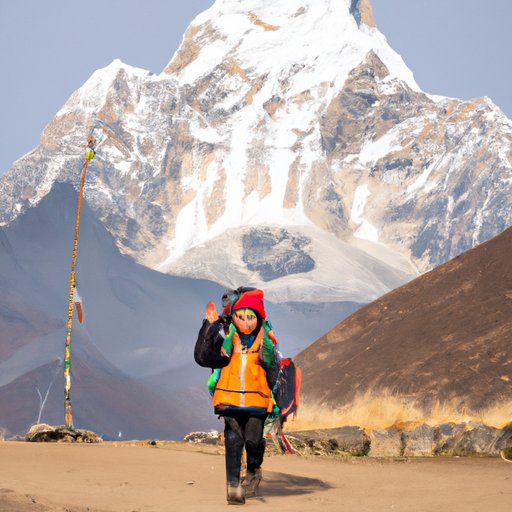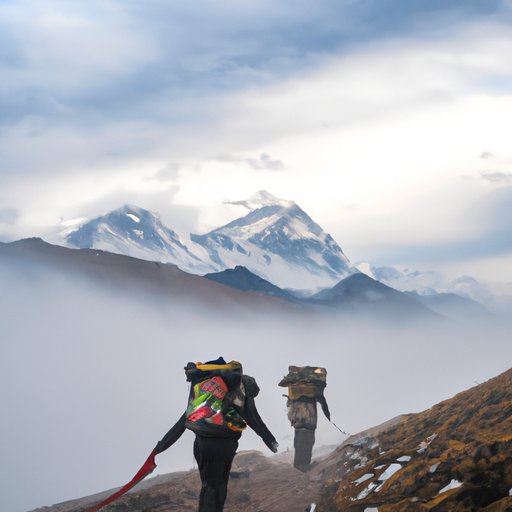I. Introduction
When it comes to the Sherpa community, most people know them as the skilled and reliable guides in the mountain climbing industry. However, there is so much more to the Sherpa people than just their mountaineering expertise. This article aims to provide a complete guide to Sherpa, exploring their culture, traditions, history, clothing, and even the impact of climate change on their communities. Whether you’re a cultural enthusiast or a mountain climbing fanatic, this ultimate guide to Sherpa has everything you need to know about this amazing community.
II. The Ultimate Guide to Sherpa: Everything You Need to Know
The Sherpa community is a unique ethnic group of people primarily residing in the high altitudes of the Himalayan regions of Nepal, Bhutan, and Tibet. The name “Sherpa” comes from the Tibetan language, meaning “people from the east.”
The Sherpas have a distinct culture and lifestyle that is closely tied to their mountainous environment. They have a reputation for being the world’s best mountaineers, thanks to their extensive knowledge of the Himalayas. Additionally, the Sherpas have a deep spiritual connection to their surroundings, which influences every aspect of their lives, from their religion to their traditions.
Definition and origin of Sherpa
The Sherpa people are a small ethnic group with a population of around 150,000, primarily living in the high altitudes of Nepal. They are known for their mountaineering expertise and their distinct culture and traditions. The origins of the Sherpa people can be traced back to the eastern Tibet region, where they initially settled. They then migrated to the Khumbu region of Nepal, where the majority of Sherpas still reside.
Characteristics and lifestyle of the Sherpa people
The Sherpa people have distinct physical and cultural characteristics that make them unique. They have a medium height and sturdy build that allows them to withstand the difficult climbing conditions. They are known for their friendly and hospitable nature, which is a fundamental aspect of their culture. The Sherpas follow a nomadic lifestyle, where they move from one place to another with their livestock depending on the season.
Overview of Sherpa language and religion
The Sherpa people have their own language called Sherpa or Sharpa, which belongs to the Tibeto-Burman language family. Their language has several dialects, and it is a tonal language that uses both vowels and consonants. Most Sherpas practice Tibetan Buddhism, which is deeply rooted in their daily lives and traditions. They also have their own animistic beliefs, which they mix with their Buddhist rituals.
III. Exploring the Rich Culture and History of the Sherpa People
The Sherpa people have a rich cultural heritage that dates back to several centuries. Their culture has evolved with time and has been influenced by their surroundings and the people they interacted with throughout history. Their traditions and practices encompass every aspect of their lives, from birth to death.
History and migration of the Sherpa people
The earliest records of the Sherpa people can be traced back to the 15th century. These records indicate that the Sherpas were originally from the eastern Tibet region, where they mainly subsisted on farming and animal husbandry. The Sherpas migrated to the Khumbu region of Nepal around the 18th century. Since then, they have primarily relied on animal husbandry and trade to earn a living.
Cultural traditions and practices of the Sherpa community
The Sherpas have unique cultural traditions and practices that are deeply rooted in their daily lives. They have a rich history of art, music, and dance that they use to pass down their traditions to future generations. Some of their cultural practices include the Mani Rimdu festival, which is a religious festival celebrated in autumn, where they perform traditional dances and offer prayers.
Famous Sherpas and their contributions to society
The Sherpa community has produced some of the world’s greatest mountaineers, who have made significant contributions to society. Tenzing Norgay, a Sherpa mountaineer, was the first person to climb Mount Everest along with Sir Edmund Hillary in 1953. Another famous Sherpa, Ang Rita Sherpa, holds the record for the most ascents of Mount Everest without the use of supplemental oxygen.
IV. The Role of Sherpas in Mountaineering: A Comprehensive Overview
The Sherpas are known as the backbone of the mountaineering industry, and their expertise is highly valued in the world of mountaineering. They have an in-depth understanding of the Himalayas, and their ability to adapt to the high altitude environment is unmatched.
Description of Sherpa’s expertise in high altitude mountaineering
The Sherpas have an inherent ability to adapt to the extreme conditions at high altitudes. They have evolved physically to live in these conditions and can withstand the low oxygen levels, cold temperatures, and adverse weather conditions. This unique ability makes them ideal for high altitude mountaineering.
The role of Sherpa in assisting mountaineers and carrying supplies
Sherpas have been an integral part of most successful mountaineering expeditions. They serve as guides, porters, and assistants to the climbers and carry essential supplies required for the journey. They are responsible for setting up camps, preparing food, and ensuring the safety of the climbers.
Challenges and risks faced by Sherpas in mountaineering
Sherpas face several risks and challenges while working in the mountaineering industry. The high altitude environment, unpredictable weather, and challenging terrain make mountaineering a dangerous profession. Furthermore, the risk of altitude sickness and hypothermia is high in these conditions.
V. Sherpa Clothing Through the Ages: From Traditional Attire to Modern Wear
Sherpa clothing has a rich history and has evolved over the years, reflecting the changing lifestyles and cultural practices of the community. Their traditional attire is unique and has become an essential part of their culture and identity.
Description of traditional Sherpa clothing and accessories
Traditional Sherpa clothing consists of multi-layered warm, robust, and heavy fabrics that keep them warm in the harsh conditions of the Himalayas. They wear a thick woolen robe called a chuba, which is fastened at the waist with a belt. They also wear a sleeveless vest called a bhakhu, which is adorned with colorful embroidery and made from yak wool.
The evolution of Sherpa clothing to modern-day fashion trends
Sherpa clothing has evolved to modern-day fashion trends, with trendy and stylish designs that appeal to the younger generation. Several Sherpa-owned businesses have emerged, selling Sherpa-inspired clothing and accessories globally.
How Sherpa clothing has become popular and influenced fashion
Sherpa clothing has become popular globally, with several fashion designers incorporating Sherpa-inspired designs into their collections. The Sherpa community has influenced the fashion industry with their traditional clothing, inspiring new designs and trends.

VI. Sherpa Tourism: How Sustainable Travel is Supporting Local Communities
Sherpa tourism is a popular industry in Nepal, Bhutan, and Tibet, attracting thousands of visitors every year. The tourism industry has played a significant role in the development of the Sherpa community, providing employment opportunities and supporting local livelihoods.
Explanation of tourism industry in Sherpa communities
Sherpa communities rely on tourism as a significant source of income. Several trekking routes in the Himalayas attract tourists, giving them an opportunity to experience the Sherpa culture and traditions.
Importance of responsible and sustainable tourism
The importance of responsible and sustainable tourism cannot be overemphasized in the Sherpa community. The tourism industry should prioritize sustainable development while promoting the Sherpa culture and traditions, ensuring the preservation of the environment and the community’s heritage.
How Sherpa tourism is benefiting local communities and their livelihoods
Sherpa tourism provides several benefits to the local communities, including job creation, income generation, and the promotion of their culture and traditions. The tourism industry has also supported local development through community-based projects that focus on enhancing education, healthcare, and infrastructure.
VII. The Impact of Climate Change on Sherpa Communities and Their Livelihoods
The Sherpa community is facing the adverse effects of climate change, which threatens to change their natural environment and threatens their livelihoods.
Explanation of climate change impact on Sherpa’s natural environment
Climate change is causing a loss of snow and glacier ice in the Himalayas, which have a significant impact on the mountain ecosystems. The Himalayas are the source of most of Asia’s major rivers, and the melting glaciers affect the water supply and hydroelectric power production capacity.
How climate change is affecting Sherpa community’s economy and lifestyle
The melting glaciers in the Himalayas have dire consequences for the Sherpa community. The reduced water sources have significant implications for agriculture, tourism, and energy sectors, which the Sherpas rely on for their livelihoods. Furthermore, the melting glaciers also increase the risk of flooding and landslides in the region.
Efforts to combat climate change and protect Sherpa communities
Several efforts are underway to combat climate change and protect the Sherpa communities from its adverse effects. These include awareness campaigns, advocacy, and international cooperation to reduce carbon emissions and promote sustainable development.
VIII. Conclusion
The Sherpa community is more than just skilled mountaineers. Their culture, traditions, and way of life are an integral part of the Himalayan region’s identity. This guide has explored the rich culture and history of the Sherpas, their clothing, impact on tourism, and the challenges they face due to climate change. It’s up to us to appreciate and support the Sherpa community, ensuring that their heritage is preserved for future generations.
